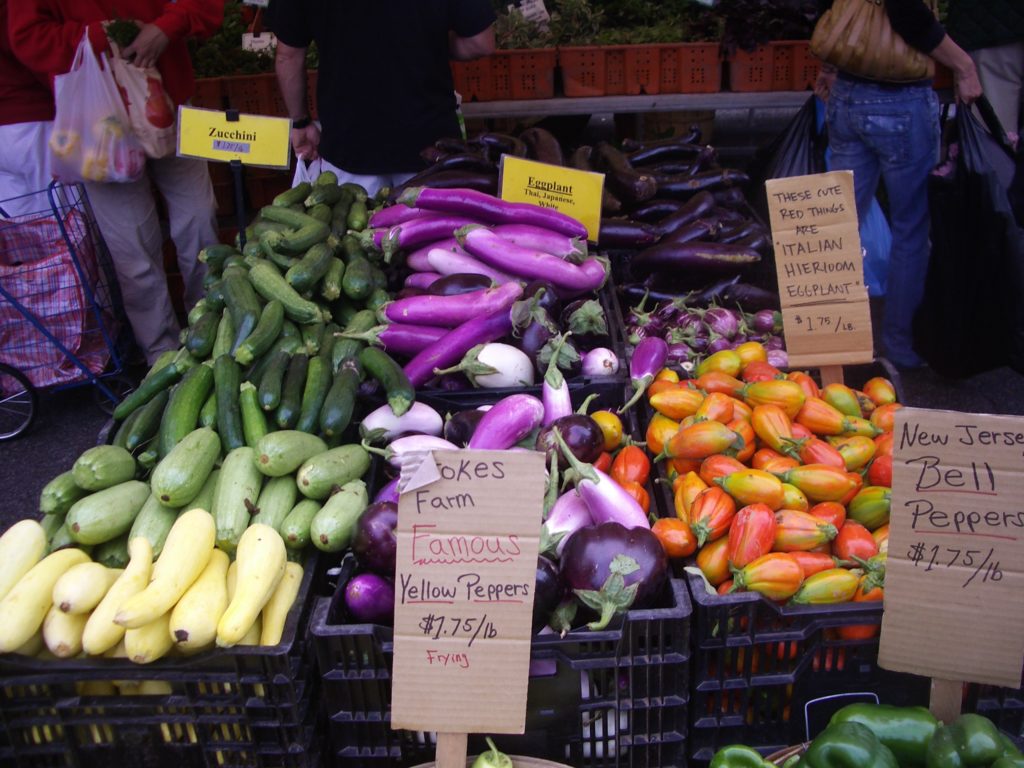This is the first of a series of essays for my class, The Creative Founder. Follow our progress in our Medium Publication, The Creative Founder.

You’ve probably been to a farmer’s market. Picture yourself there. There are people walking around, all interested in affordable fresh produce. There are stands from local farmers showing off their fruits and vegetables, and perhaps fish and meat. Sometimes there is prepared food as well, or crafts. There is almost always a musician taking advantage of the crowd to play in exchange for tips.
This is a market in more ways than one. It’s also a perfect example of what business folks say when they talk about “markets.” It’s a sloppy term. I’ve seen a lot of definitions floating around, and even sloppier usage.
So for the sake of argument, let’s agree that for The Creative Founder, we’ll define markets as
“A group of people who share a purchasing desire, decision criteria and demographic/psychographic influences.”
And now I’ll break that down.
- A group of people: Well, yes. Markets, like Soylent Green, are made of people. First, last and always, and this should never be forgotten.
- Who share: a market is defined by what the people in it have in common, though one must also be aware of what they don’t share.
- A purchasing desire: Food. Travel. Health care.
- Decision criteria: fresh, local, affordable. Possibly organic, humane, exotic.
- Demographic and psychographic influences: here is where we get ourselves in trouble if we don’t do our research. Being a woman, a person of color, poor, midwestern, senior, young, and more can influence our decisions, especially when those decisions are around the unique properties each of those demographics has. BUT this is also the land of stereotypes and lazy thinking. So proceed with caution.
One custom that makes markets hard to talk about is that people refer to them by the product that dominates them, i.e. “travel booking aggregators.” Never forget that under that product is a group of people who want certain things the way them want them. By recognizing that booking aggregators exist because of people who want cheap flights, but also the flights are the right time and the right airline and many more purchasing criteria.
So Steve Blank, in Four Steps to the Epiphany, named four types of markets. Later, he added one.

- Entering an existing market. This is frequently a “better” play. We know that there is a market for booking aggregators, but ours will be better. Faster, more comprehensive, easier to use… etc.
- New, A.K.A. Blue Ocean Strategy. Cirque Du Soleil is the example that is often given, but I think the Sony Walkman is better. No one knew they wanted to have their music in their pocket to take with them everywhere, until that device appeared. Everything Steve Jobs built with the iPod and iPhone was because the Walkman realized we want our music with us always.
3. Segmented by Price.
 Much like #1, though the better is cheaper. Old Navy is a segmentation of Gap’s casual wear market.
Much like #1, though the better is cheaper. Old Navy is a segmentation of Gap’s casual wear market.
But it can also go the other way, and become more expensive. BMW, Omega and perhaps even the iPhone are not *that* different than more affordable alternatives, but they have a cachet desired by the well to do.
4. Segmented by Niche. Pick a subset of a big healthy market, and serve them better. For example, sports clothing was segmented into yoga practitioners, and now it’s a thriving market. Mostly because yoga clothes are as comfortable as sweatsuits, but much better looking.
5. Clone market. This is when you take something that is working in another “market” (frequently geographic defined) and move it to a new one that has similar needs. Baidu (search engine) was a clone of Yahoo/Google, but in China.
So what is our farmer’s market?

It’s a resegmentation based on both price and niche AND it’s a clone. Farmer’s markets have existed around the world and in our own past. They were replaced by supermarkets, but the rise of interest in local/better eating created the demand that allowed their massive return.
Everyone has to eat, but not everyone wants to cook. We can take supermarkets as the big “market” serving people who want to eat food at home and are willing to do some cooking. Whole Food segments that market to serve people with money who want a higher quality and a higher moral production of that food (we can argue.) Trader Joe’s further resegments that to people who want low-cost higher quality and a higher moral production. Farmer’s markets does all that, with community.
All three of these manage to also serve people who don’t actually want to do the cooking, but want the same quality of fresh, healthy ingredients as those who do. Markets often grow out to serve similar values beyond that which originally defined them. How else can we explain the Farmer’s Markets ubiquitous musicians? Do people who like their food fresh like their music fresh also? Or maybe community is at the heart of the farmer’s market segmentation, and those products that promote community will always thrive there. Psychographics can help you understand and extend your market.
More on market Types from Steve Blank, OG of startup creation as rational process.
Working with the Market Types
As my students search for a market to serve, they need to examine their interests and passions as well the opportunities. If a student loves travel — avery crowded market — they’ll have to decide if they want to try to resegmentit or compete on a “better” advantage. But they also might come up with anew kind of travel that is compelling but hasn’t been proven yet. Or they might want to bring something that works in their home country to a new one. Or something that art students love that the rest of the world doesn’t know about yet, like Moleskine (yes, you all know about Moleskine now, bear with me.)
I think of Market Types as a way to generate potential approaches to entering a market.
Next Essay: How to Pick a Market